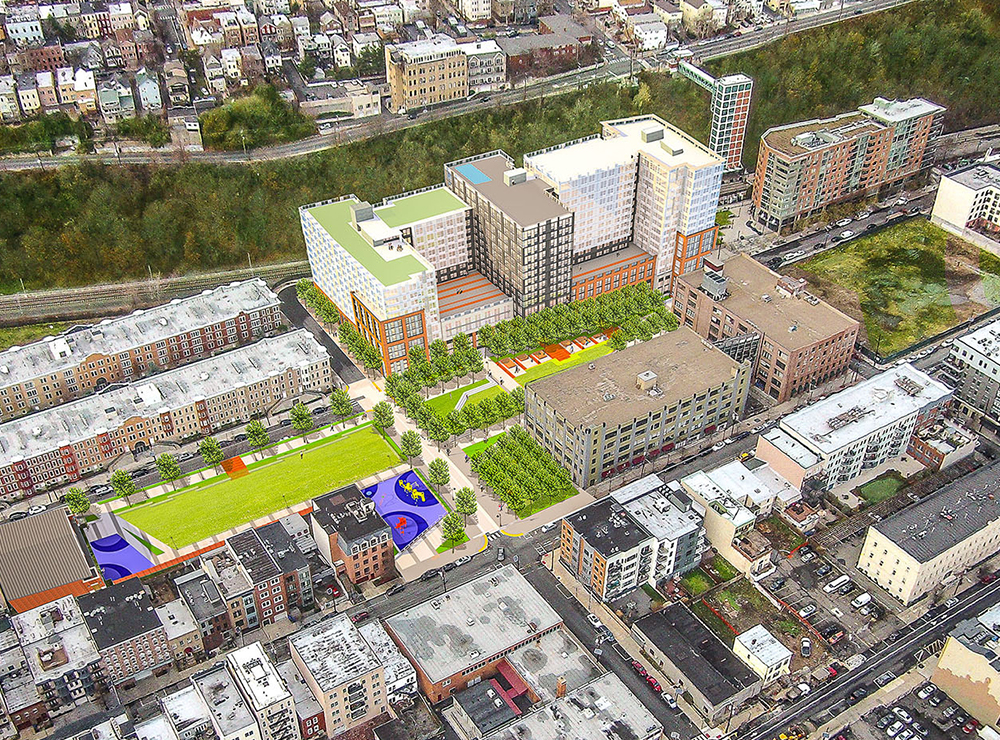
Urban Mixed-use Redevelopment: 700 Jackson, Hoboken
Urban Mixed-use Redevelopment
LOCATION:
700 Jackson St., Hoboken, NJ 07030
MUNICIPALITY/NEIGHBORHOOD:
City of HobokenJennifer Gonzalez, AICP, PP, CFM, ENV SP, LEED GA, Director of Environmental Services/Chief Sustainability Officer
DEVELOPER/ DESIGN TEAM:
Bijou Properties
David Garber, Partner & CFO
Chris Mazzola, Development Manager
Matthew Testa, Director of Construction
Intercontinental Development, Inc. Marchetto Higgins Stieve Architect
Langan
Leonard D. Savino, PE, Principal Sony David, PE, Associate
Gregg Woodruff, PP, AICP, LEED-AP BD+C, Associate/Sustainability Leader
SEWER TYPE:
Combined Sewer Overflow
North Hudson Sewerage Authority
COMPLETION DATE:
Completed
Project Overview
700 Jackson Street Redevelopment and Resiliency Park is a mixed-use development in the City of Hoboken. The project is a public-private partnership led by local developer Bijou Properties and its partner, Intercontinental Real Estate. The redevelopment is part of a larger effort by the City to manage flooding and build resiliency through large-scale stormwater management. The site contains a public park and plaza, a public gymnasium, 424 apartment units, a parking garage, and 30,000 square feet of retail space. Perhaps most impressive is the approximately 450,000 gallons of stormwater storage that will reduce localized flooding.
In 2013, the City of Hoboken developed a Green Infrastructure Strategic Plan which identified this site as a potential resiliency park to retain stormwater. Concurrently, the United States Department of Housing and Urban Development (HUD) initiated the “Rebuild by Design” (RBD) competition as a tool for funding resiliency strategies in the aftermath of Hurricane Sandy. The RBD competition developed a comprehensive water management strategy for Hoboken consisting of four integrated components: resist, delay, store, and discharge. HUD awarded the State of New Jersey $230 million to construct the resist component, which will reduce coastal flooding. The City and partners are working to implement the delay, store, discharge components which will reduce rainfall flooding. The 700 Jackson site, already identified as a potential redevelopment site by the City, became part of the City’s efforts to delay and store rainwater as a resiliency park.
As part of the development agreement, the developer designed and built a public component for the project which includes a 6,835-square-foot gymnasium, public open space, and an underground stormwater detention system. The public gymnasium, public open space, and stormwater system components of the project were completed early in the construction of the overall mixed-use development; ownership of those spaces has been turned over to the City. As part of the redevelopment design for this site, the City and developer prioritized the public space. This strategy resulted in the consolidation of development from the entire site to approximately one-third of the site through increased building height. The remaining two-thirds of the site served as area for the public space amenities.
The project exemplifies how to design a complex site within challenging urban conditions while providing stormwater management beyond previous state requirements.

View of 770 House and adjacent park during construction. The park provides added value to the mixed-use building
as well as stormwater storage. Image Credit: Bijou Properties, 2020

Active green roof on the 770 House building. Residents can enjoy views of Hoboken while planters and lawn areas
allow for added green space. Image Credit: Bijou Properties, 2020
Design Summary
The design of the 700 Jackson site evolved over time to maximize flood control and meet the City’s water management goals of delay, store, and discharge. The existing parcels consisted of entirely impervious surfaces. Through the creation of green space and reduction of existing impervious surface alone, the design would have been exempt from state water quality standards. However, working with the City and the North Hudson Sewerage Authority (NHSA), the design team went above and beyond requirements to provide additional treatment in the form of green roofs and an underground stormwater detention system.
- Green roofs will be used on areas of the proposed mixed-use complex. Both active and passive roofs are proposed. In the passive green roofs, sedum tray systems will be used to collect, store, and slowly release stormwater. The stormwater will then be directed to the underground detention system via pipes. The active roofs contain planters and usable space for tenants. The planters will reduce impervious surfaces and collect rain water.
- Underground Detention is the primary form of stormwater management. The system consists of High-Density Polyethylene (HDPE) pipes laid in a clean stone bed. This project includes connections from the underground detention to existing catch basins in the Right-of-Way in order to collect some stormwater from City streets immediately surrounding the site. An Opti sensor is installed as a way of controlling stormwater release from the site’s underground stormwater detention system prior to it being discharged to the City’s combined sewer overflow (CSO) system. The sensor will communicate with sensors throughout the CSO system. NHSA will remotely control the sensors via cloud to strategically release flows and reduce the impact on the CSO system.
Decision-Making
The selection of the stormwater system was primarily dictated by the realities of physical constraints on the site, specifically the shallow depth to groundwater and poor infiltration capacity associated with that condition. Stormwater design measures that were considered include a more dispersed storage approach and infiltration features. However, these alternatives were determined to be infeasible due to the shallow depth to groundwater.
Maintenance was another factor in the decision-making process. Because the stormwater detention system is located on the public parcel, there were concerns over debris and trash clogging surface systems.
- Green roofs were installed as both a stormwater management measure and an aesthetically valuable asset. These BMPs are incorporated as amenities for future tenants.
- Underground Detention was selected as the most effective measure for stormwater management on this particular site. The shallow depth to groundwater rendered infiltration impossible and eliminated BMPs with deeper profiles. Other forms of underground detention systems were also evaluated. Concrete chambers optimize storage but require heavy equipment for installation. The use of cranes in an urban environment can lead to road closures and complications in the construction process. The selected HDPE pipe with stone encasement is a straightforward design with relatively easy install and adequate storage for the proposed flood control.

Interior of 770 House. The development features high-end amenities, including green roofs. Image Credit: Bijou Properties, 2020
Challenges
The site’s urban context presented a number of challenges for the design team. The majority of Hoboken has shallow depth to groundwater, numerous existing utilities, and intensive pedestrian and vehicular traffic. These constraints guided design decisions and offer learning opportunities for developers working under similar conditions.
- Groundwater: Shallow depth to groundwater can limit the types of BMPs used. The design team was not able to provide adequate separation to groundwater for infiltration BMPs while providing the required flood storage and remaining within the project’s budget. Under other conditions, dispersed green infrastructure may have proved more effective. However, each case is site-specific and should be evaluated as a unique circumstance. Infiltration testing and soil borings should be conducted early in the design process. In this case, elevating the chosen BMPs off of the ground in the form of green roofs was deemed more efficient and cost effective than shallow surface features at the ground level of the site.
- BMP Construction: The design of BMPs in urban areas can be restricted based upon adjacent traffic patterns and safety concerns. Simplifying BMP design to avoid road closures proved most efficient for the design team. Detailed design plans further eased the construction process
Maintenance Overview
The design team kept maintenance in mind throughout the design process. With the knowledge that the public portion of the project would be handed off to the City, access to the system and maintenance procedures were kept simple.
Maintenance for the underground system will be performed by the North Hudson Sewerage Authority through an interlocal agreement with the City. Hoboken’s strategy for maintaining green infrastructure and flood control throughout the City is evolving with the increase in systems. Hoboken recently hired a landscape contractor to maintain all City-owned vegetated green infrastructure BMPs.
